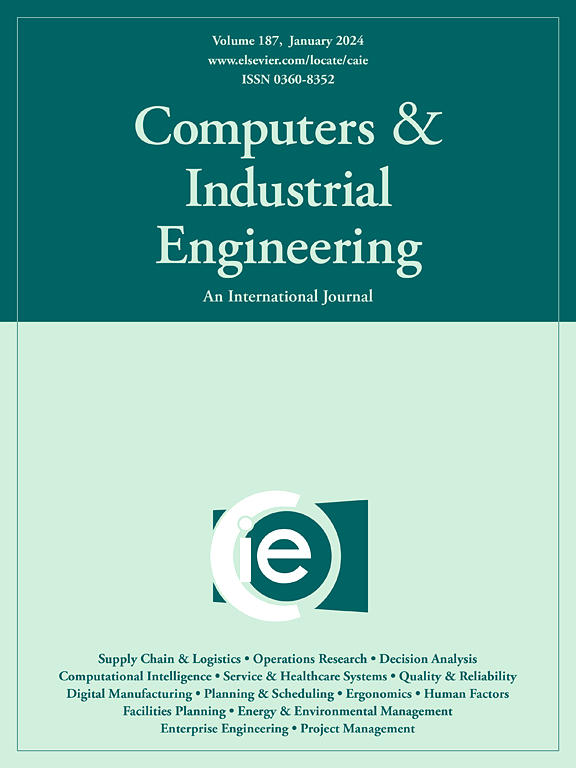城市轨道站自由浮动自行车共享的全系统优化:需求预测与调度方法
IF 6.7
1区 工程技术
Q1 COMPUTER SCIENCE, INTERDISCIPLINARY APPLICATIONS
引用次数: 0
摘要
自由浮动共享单车(FFBS)解决了城市轨道交通(URT)的第一/最后一英里挑战,同时也面临着由于不受限制的自行车停放而导致的供需失衡问题。以前的研究主要将实际自行车使用量与需求等同起来,并关注成本效益,而忽略了未满足的需求和系统范围的优化。本研究提出了一个全面的框架,通过1)需求预测,2)基于时间的调度,3)优先调度策略和4)系统范围的优化来优化轨道交通站点FFBS的可用性,特别是在高峰时段。该方法将城市轨道交通客流量作为关键特征,提高了城市轨道交通换乘场景下共享单车需求预测的准确性。为了实现自行车调度效益,本研究引入了一种基于网格的方法,将骑行数据转换为自行车调度的预测订单,测量跨交通模式节省的时间。此外,基于城市轨道交通站点周围公交路线的分类,设计了自行车分配的优先级策略,确保了FFBS和其他公共交通方式的平衡整合。设计了一种多目标优化模型,以最小化运营成本和最大化节省乘客时间为目标,并采用NSGA-III算法进行求解。一项利用深圳公共交通数据的数值研究显示,与非优先站点相比,优先选择站点可以使每笔订单平均节省19.4%的时间,同时减少7.60%的总乘客出行时间。本研究更准确地反映了实际需求,从而实现了ut - bbs转移的供需平衡。本文章由计算机程序翻译,如有差异,请以英文原文为准。
System-Wide Optimization of Free-Floating Bike-Sharing for Urban Rail Stations: A demand prediction and scheduling approach
Free-floating bike-sharing (FFBS) addresses the first/last mile challenges in urban rail transit (URT), while facing supply–demand imbalance problems owing to unrestricted bike parking. Previous research primarily equated actual bike usage with demand and focused on cost-efficiency, which overlooks unmet demand and system-wide optimization. This study proposes a comprehensive framework to optimize FFBS availability at URT stations, particularly during peak hours, through 1) demand prediction, 2) time-based scheduling, 3) priority scheduling strategy, and 4) system-wide optimization. The proposed method incorporates URT ridership as a pivotal feature to enhance the accuracy of bike-sharing demand prediction in URT transfer scenarios. To achieve bike-scheduling benefits, this study introduces a grid-based approach to convert ride data into predictive orders for bike scheduling, measuring time savings across transit modes. Additionally, a prioritization strategy for bike redistribution is designed based on the classification of bus routes around URT stations, ensuring a balanced integration of FFBS and other public transport modes. A multi-objective optimization model is designed to minimize operating costs and maximize passenger time savings, which is addressed with the NSGA-III algorithm. A numerical study using Shenzhen’s public transportation data reveals that prioritizing selected stations leads to a 19.4% greater average time savings per order compared to non-priority stations, along with a 7.60% reduction in total passenger travel time. This study more accurately reflects the actual demand, thereby achieving the supply–demand balance in URT-BBS transfers.
求助全文
通过发布文献求助,成功后即可免费获取论文全文。
去求助
来源期刊

Computers & Industrial Engineering
工程技术-工程:工业
CiteScore
12.70
自引率
12.70%
发文量
794
审稿时长
10.6 months
期刊介绍:
Computers & Industrial Engineering (CAIE) is dedicated to researchers, educators, and practitioners in industrial engineering and related fields. Pioneering the integration of computers in research, education, and practice, industrial engineering has evolved to make computers and electronic communication integral to its domain. CAIE publishes original contributions focusing on the development of novel computerized methodologies to address industrial engineering problems. It also highlights the applications of these methodologies to issues within the broader industrial engineering and associated communities. The journal actively encourages submissions that push the boundaries of fundamental theories and concepts in industrial engineering techniques.
 求助内容:
求助内容: 应助结果提醒方式:
应助结果提醒方式:


